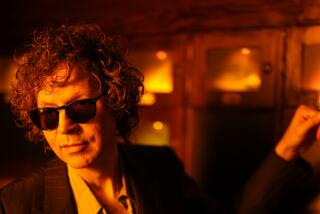‘The Rest Is Noise, Listening to the Twentieth Century’ by Alex Ross
[This Book Review originally ran in the Los Angeles Times on Nov. 11, 2007]
A unified, comprehensive history of 20th century music is the philosopher’s stone of modern criticism: How to transmute such vast, maddening complexity into conceptual gold? It’s like trying to nail quicksilver to the wall: What do you even call the stuff? The term “classical music” was obsolete before the century began, with the eccentric sound palaces of Strauss and Mahler. By the contemporary era, with the likes of John Adams and Philip Glass, the “classical” label had become ludicrously inapt.
Whatever you call it, music in the 20th century exploded into a dazzling, perplexing array of styles that far outran the audience’s ability to keep up. There is a deep connection between Strauss’ cacophonous “Elektra” and John Cage’s experiments in silent composition, but it would take a brave man to attempt such a bold synthesis.
Alex Ross is the man. In “The Rest Is Noise,” the music critic of the New Yorker attempts to embrace the full range of 20th century music: to describe its sounds; to trace its evolution; and , to elucidate the profound impact of music on modern history, and vice versa. What powers this amazingly ambitious book and endows it with authority are the author’s expansive curiosity and refined openness of mind.
Ross begins in 1906 with the first performance of “Salome” in Graz, conducted by Strauss, a historic evening that brought under one roof Puccini, Mahler, Schoenberg and (so he would later claim) the adolescent Adolf Hitler. The book concludes with the 1987 premiere of Adams’ “Nixon in China” in Houston. Ross provides engrossing, authoritative accounts of the emergence of atonality and 12-tone music; the interlock between the rise of modernism in music and dance, in the ballets of Debussy and Stravinsky; and Shostakovich’s tormented relationship with Stalin. Like any good encyclopedist, he draws on the best existing expertise. Yet many of his most fascinating pages arise from the author’s far-ranging primary research into subjects previously known primarily to academic specialists.
A biographical sketch of 19th century African American violinist and composer Will Marion Cook is as moving as that of many better-known composers. The debut of Cook’s opera based on “Uncle Tom’s Cabin,” planned for the 1893 World’s Fair , was canceled because the female lead didn’t have train fare to Chicago. After Cook’s Carnegie Hall debut, when a well-meaning critic gave him left-handed praise, Cook stormed into his office and proclaimed, “I am not the world’s greatest Negro violinist. I am the greatest violinist in the world!”
Combing through the archives of the American occupation of postwar Germany, Ross spins a surprising narrative about the Psychological Warfare Division’s attempts to denazify the musical scene there. One early memo states, “It is above all essential that we should not give the impression of trying to regiment culture in the Nazi manner,” while successive documents describe a “democratic” musical canon almost as strict as the National Socialists’. Even Sibelius, then probably the world’s most popular living composer, was suspect, Ross writes, because his works might “reawaken feelings of Nordic supremacy.”
Ross digs up fascinating material about the many European composers who expatriated to L.A. during the 1930s. Schoenberg, the pontifex maximus of atonality, lived in Brentwood, a few miles from the other giant of musical modernism, Stravinsky. Rachmaninov was on North Elm Drive; conductor Otto Klemperer was a neighbor of Otto Preminger’s. The images of Schoenberg are unforgettable, whether playing tennis with the Gershwins or matching wits with Fanny Brice, the brassy star of the Ziegfeld Follies. She cornered the composer of “Moses und Aron” at a party and said, “C’mon, Professor, play us a tune.”
Paradoxically, “The Rest Is Noise” gains much of its intellectual authority from the fearless attitude of its author toward popular culture. Ross’ erudition and grasp of the highbrow curriculum is unquestionable, but what sets him apart from most music critics is the familiar ease with which he also addresses jazz and rock, film and television. His is a sweet and generous voice. He has no grand theory to prove, no idols to smash.
Obviously, there is a strong element of taste evident in his book, but he is never pretentious or dismissive of artists. His rare bursts of outright disapproval are reserved for excessively disapproving critics, as when he slams the diatribes of Virgil Thomson and Theodor Adorno as “revoltingly snooty” -- mild language for the modernist wars.
After nearly 500 pages of brilliant synthesis, Ross meanders and turns a bit flabby in describing the latter 20th century. It’s not entirely his fault: With the splendid exception of Adams, by century’s end the music itself was frequently meandering and flabby. The most salient fact of contemporary musical life is the mass flight of the audience, an issue Ross raises only reluctantly: “To the cynical onlooker, orchestras and opera houses are stuck in a museum culture, playing to a dwindling cohort of aging subscribers and would-be elitists. . . .” In answer, he offers a hopeful view that falls far short of the tough-minded standard governing the rest of his book: “Confusion is often a prelude to consolidation; we may even be on the verge of a new golden age.”
It hardly takes a cynic to doubt this sunny outlook; the composers he invokes to support it are names scarcely known even to regular concertgoers. Yet a grateful reader is inclined to grant a thinker of such lively learning and imagination his parting burst of optimism: Nowadays, it’s in short supply.
More to Read
Sign up for our Book Club newsletter
Get the latest news, events and more from the Los Angeles Times Book Club, and help us get L.A. reading and talking.
You may occasionally receive promotional content from the Los Angeles Times.







